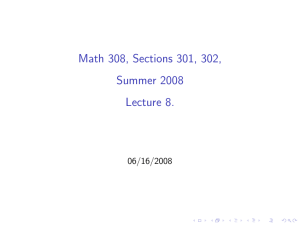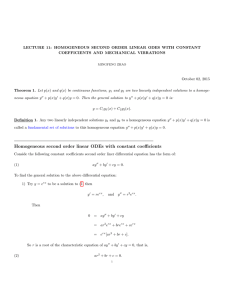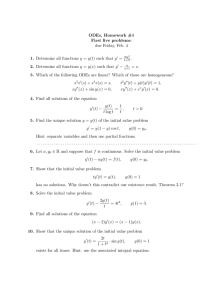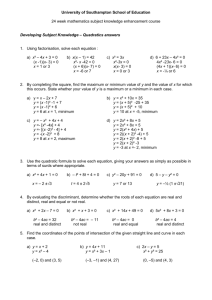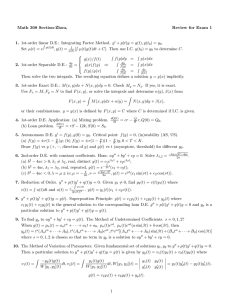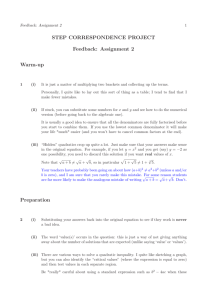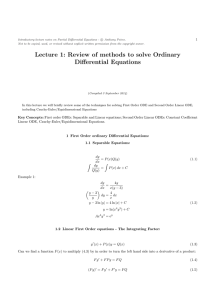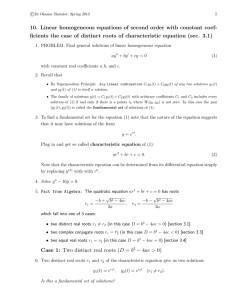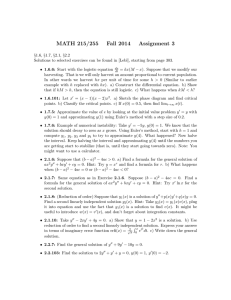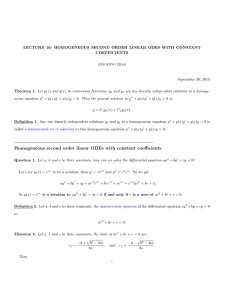LECTURE 9: SECOND ORDER LINEAR ODES September 22, 2014 = f (y):
advertisement
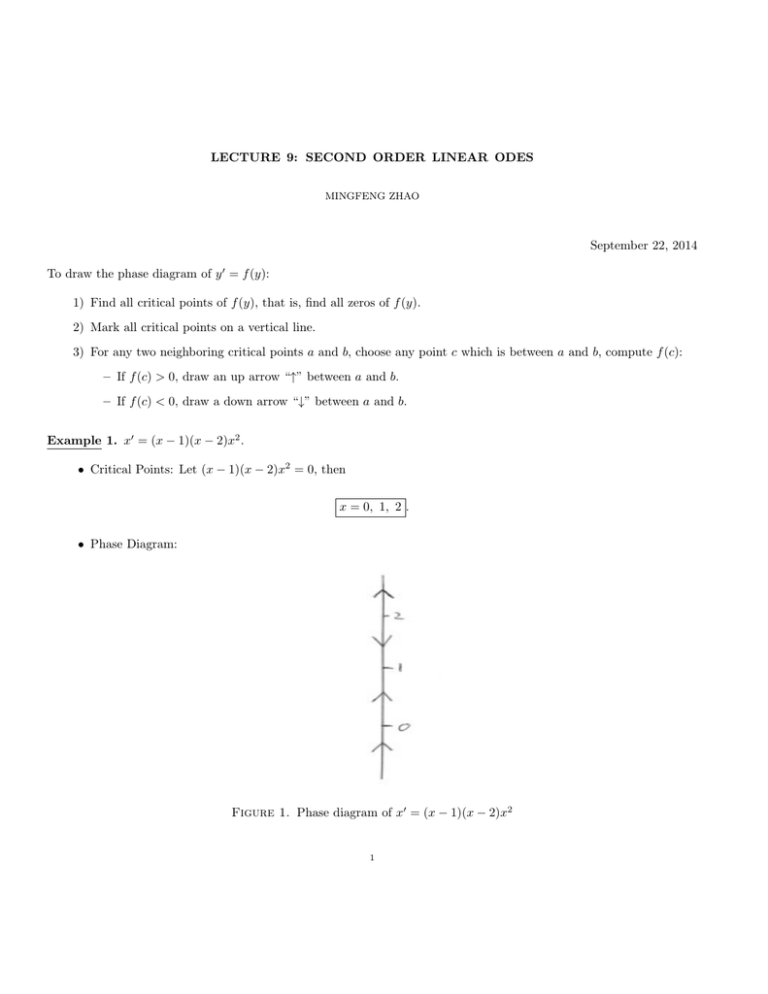
LECTURE 9: SECOND ORDER LINEAR ODES MINGFENG ZHAO September 22, 2014 To draw the phase diagram of y 0 = f (y): 1) Find all critical points of f (y), that is, find all zeros of f (y). 2) Mark all critical points on a vertical line. 3) For any two neighboring critical points a and b, choose any point c which is between a and b, compute f (c): – If f (c) > 0, draw an up arrow “↑” between a and b. – If f (c) < 0, draw a down arrow “↓” between a and b. Example 1. x0 = (x − 1)(x − 2)x2 . • Critical Points: Let (x − 1)(x − 2)x2 = 0, then x = 0, 1, 2 . • Phase Diagram: Figure 1. Phase diagram of x0 = (x − 1)(x − 2)x2 1 2 MINGFENG ZHAO • Classify the critical Points: x = 0 is a node(unstable), x = 1 is a sink(stable), x = 2 is a source(node) . • For the initial value problem: x(0) = 0.5. Since 0 < x(0) = 0.5 < 1, then x0 (0) = (0.5 − 1)(0.5 − 2)(0.5)2 > 0, and lim x(t) = 1 . t→∞ Second oder linear ODEs A general second order linear differential equation is of the form: A(x)y 00 + B(x)y 0 + C(x)y = F (x). Or y 00 + p(x)y 0 + q(x)y = f (x). If f (x) = 0, we say that y 00 + p(x)y 0 + q(x)y = 0 is homogeneous. Example 2. y 00 − k 2 y = 0 is homogeneous. It’s easy to check that y1 = ekx and y2 = e−kx are two solutions to y 00 − k 2 y = 0. Example 3. y 00 + k 2 y = 0 is homogeneous. It’s easy to check that y1 = cos(kx) and y2 = sin(kx) are two solutions to y 00 + k 2 y = 0. Theorem 1 (Superposition). Let y1 and y2 be two solutions to a homogeneous equation y 00 + p(x)y 0 + q(x)y = 0, then for any two constants C1 and C2 , y(x) = C1 y1 (x) + C2 y2 (x) is also a solution to y 00 + p(x)y 0 + q(x)y = 0. Proof. In fact, since y(x) = C1 y1 (x) + C2 y2 (x), then we have y 00 + p(x)y 0 + q(x)y = [C1 y1 (x) + C2 y2 (x)]00 + p(x)[C1 y1 (x) + C2 y2 (x)]0 + q(x)[C1 y1 (x) + C2 y2 (x)] = C1 y100 (x) + C2 y200 (x) + C1 p(x)y10 (x) + C2 p(x)y20 (x) + C1 q(x)y1 (x) + C2 q(x)y2 (x) = C1 [y100 (x) + p(x)y10 (x) + q(x)y1 (x)] + C2 [y200 (x) + p(x)y20 (x) + q(x)y2 (x)] = 0 Since both y1 and y2 are solutions. So y(x) = C1 y1 (x) + C2 y2 (x) is also a solution to y 00 + p(x)y 0 + q(x)y = 0 . LECTURE 9: SECOND ORDER LINEAR ODES 3 Example 4. y 00 − k 2 y = 0. By Theorem 1, cosh(x) = ekx + e−kx is also a solution to y 00 − k 2 y = 0. 2 Theorem 2. Let p(x), q(x) and f (x) be continuous functions on some interval I, x0 ∈ I, and b0 , b1 are constants. Then the equations y 00 + p(x)y 0 + q(x)y = f (x) y(x ) = b , y 0 (x ) = b 0 0 0 1 has only one solution on I. Definition 1. Let y1 and y2 be two function on an interval I, we say that y1 and y2 are linearly independent if one of y1 and y2 is not a constant multiple of the other. Otherwise, say y1 and y2 are linear dependent. Example 5. y1 (x) = cos(x) and y2 (x) = sin(x). Notice that y2 sin(x) = tan(x), = y1 cos(x) and y1 cos(x) = cot(x). = y2 sin(x) It’s easy to see that neither tan(x) nor cot(x) are constant functions, then y1 = cos(x) and y2 = sin(x) are linearly independent . Theorem 3. Let p(x) and q(x) be continuous functions, y1 and y2 are two linearly independent solutions to a homogeneous equation: y 00 + p(x)y 0 + q(x)y = 0. Then the general solution to y 00 + p(x)y 0 + q(x)y = 0 is: y = C1 y1 (x) + C2 y2 (x). Definition 2. Any two linearly independent solutions y1 and y2 to a homogeneous equation y 00 + p(x)y 0 + q(x)y = 0 is called a fundamental set of solutions to this homogeneous equation y 00 + p(x)y 0 + q(x)y = 0. Example 6. y 00 + k 2 y = 0, k is a nonzero constant. The general solution to y 00 + k 2 y = 0 is: y = C1 cos(kx) + C2 sin(kx) . 4 MINGFENG ZHAO Constant coefficients second order linear ODEs In this lecture, we always assume that a, b and c are three constants, let’s consider the differential equation: ay 00 + by 0 + cy = 0. Question 1. Let a, b and c be three constants, how can we solve the differential equation: ay 00 + by 0 + cy = 0. Definition 3. Let a, b and c be three constants, the characteristic equation of the differential equation ay 00 +by 0 +cy = 0 is: ar2 + br + c = 0. Example 7. y 00 − 8y 0 + 16y = 0. The characteristic equation of y 00 − 8y 0 + 16y = 0 is: r2 − 8r + 16 = 0 . Theorem 4. Let a, b and c be three constants, the roots of ar2 + br + c = 0 are: r1 = −b + √ b2 − 4ac , 2a and r2 = −b − √ b2 − 4ac . 2a Then 1) If b2 − 4ac > 0, then r1 and r2 are two different real numbers, and −b r1 = + 2a √ b2 − 4ac , 2a and −b r2 = − 2a √ b2 − 4ac . 2a The general solution to ay 00 + by 0 + cy = 0 is: y = C1 er1 x + C2 er2 x . 2) If b2 − 4ac = 0, then r1 = r2 = − b is a real number. The general solution to ay 00 + by 0 + cy = 0 is: 2a −b −b y = C1 e 2a ·x + C2 xe 2a ·x . LECTURE 9: SECOND ORDER LINEAR ODES 5 3) If b2 − 4ac < 0, then r1 and r2 are two different complex numbers, and √ b 4ac − b2 r1 = − + i , 2a 2a √ 4ac − b2 b r2 = − − i 2a 2a and The general solution to ay 00 + by 0 + cy = 0 is: √ y = C1 e b − 2a ·x cos 4ac − b2 ·x 2a √ ! b − 2a ·x + C2 e sin ! 4ac − b2 ·x . 2a Proof. 1) and 3) If b2 − 4ac 6= 0, let r be a solution to the characteristic equation ar2 + br + c = 0 and y = erx , then y 0 = rerx , and y 00 = r2 erx . So we get ay 00 + by 0 + cy = ar2 erx + brerx + cerx = erx ar2 + br + c = 0, Since ar2 + br + c = 0. So y = erx is a solution to ay 00 + by 0 + cy = 0. 2) If b2 − 4ac = 0, then the only solution to ar2 + br + c = 0 is r = − y 0 = erx + rxerx , b . Let y = xerx , then 2a and y 00 = rerx + rerx + r2 xerx = 2rerx + r2 xerx . So we get ay 00 + by 0 + cy = a[2rerx + r2 xerx ] + b[erx + rxerx ] + cxerx = erx 2ar + ar2 x + b + brx + cx = erx (2ar + b) + x(ar2 + br + c) = erx (2ar + b) = 0 Since ar2 + br + c = 0 Since r = − b . 2a So y = xerx is a solution to ay 00 + by 0 + cy = 0. 6 MINGFENG ZHAO Example 8. Solve y 00 − 6y 0 + 8y = 0. The characteristic equation of y 00 − 6y 0 + 8y = 0 is: r2 − 6r + 8 = 0. Solve r2 − 6r + 8 = 0, then r1 = 2, and r2 = 4. So the general solution to y 00 − 6y 0 + 8y = 0 is: y(x) = C1 e2x + C2 e4x . Department of Mathematics, The University of British Columbia, Room 121, 1984 Mathematics Road, Vancouver, B.C. Canada V6T 1Z2 E-mail address: mingfeng@math.ubc.ca
